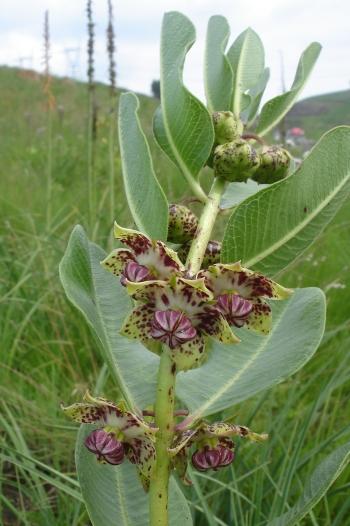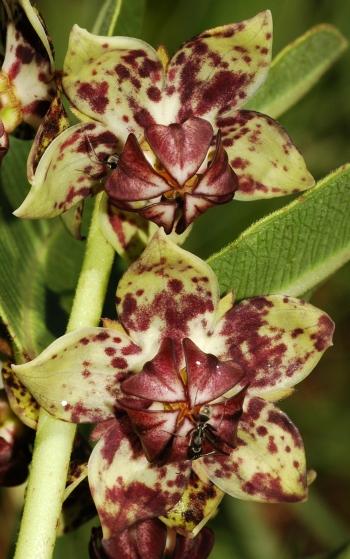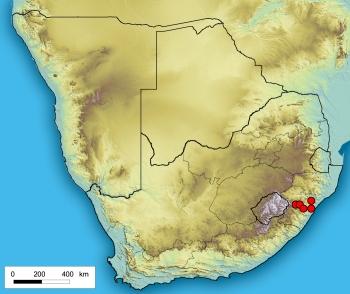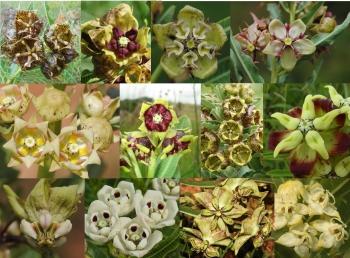Pachycarpus natalensis
Pachycarpus natalensis N.E.Br.
Family: Apocynaceae
Common names: Natal thick-fruit, Natal pachycarpus (Eng.); ishongwe elibomvu elikhulu (isiZulu)
Introduction
Pachycarpus natalensis is one of many amazingly beautiful indigenous plants, which is almost never cultivated. This is due to the short span of its flowering, perceived poisonous presence of milky latex that exudes with the smallest injury to the plant, and difficulty of getting plants established from seed or cuttings. It will make a challenging subject to cultivate in gardens, but is best appreciated in its natural environment in rocky patches in our grasslands.

Description
Description
Perennial, geophytic herb with 1 or 2 stems, which are 300–520 mm long, usually resprouting after winter (or fire) annually. The rootstock is tuberous and at least as long as the stems. The leaves are spreading-erect, lance-shaped to broadly ovate, 42–77 × 23–47 mm; the apex is obtuse, acute or acuminate, or mucronate; the base cuneate/attenuate or rounded. The midrib and secondary veins on the leaves are prominent.

The petiole is 4.0–13.2 mm long. Stalkless inflorescences carry 2–5 flowers in an umbel. The corolla of the flower is saucer-shaped, horizontally spreading and the corolla lobes are green or greenish yellow, with deep purple blotches.

The tips of the corolla are slightly reflexed, lobes free for most of their length, 11–17 × 5–12 mm. The gynostegial column, anther wings and anther appendages are completely hidden by the purple, broadly-ovate coronal blades, which are curved above the style apex. The staminal column is stipitate. The corona lobes are maroon-purple with complicate-spathulate lobes that are 5–7 mm high, basal proximal lobe 3–5 mm long, with 2, erect wings, distal appendage dilated, deltoid in shape, 7–8 mm long, inflexed to enclose style-stigma-head. In fruit, the pedicels are characteristically twisted, with the follicles ellipsoid, 95–100 × 25 mm, glabrous and 6-winged.

The seeds are 6–7 mm long, bi-facially flattened, with the one side convex, the other concave. Plants flower from October to February, but mostly in mid-summer. In drier years, plants tend to be smaller and in wetter years, they are larger in all aspects.
Conservation Status
Status
Despite the relatively restricted distribution of P. natalensis, this taxon was not selected in any of the screening processes for highlighting potential taxa of conservation concern in order for detailed conservation assessment to be done and as such, has been given an automated national threat status of Least Concern (LC).
Distribution and habitat
Distribution description
Pachycarpus natalensis is a South African endemic species found in KwaZulu-Natal and the Eastern Cape. Plants are found widespread in midland and upland grasslands, frequently in rocky areas, at altitudes from 600–1 200 m. The map shows herbarium specimens located in the National Herbarium in Pretoria (PRE) only.

Derivation of name and historical aspects
History
The generic name is derived from the Greek words pachys, ‘thick’ and karpos, ‘a fruit’, in reference to the enlarged large fruits that most species in this genus develop. The epithet natalensis, is in reference to the geographical distribution of the taxon when first described. At the time N.E. Brown described this taxon all the specimens available to him came from Natal, now KwaZulu-Natal, and hence he used this as the specific epithet.

The genus Pachycarpus consists of about 27 taxa of which most are found in southern Africa, but some members also extend to tropical Africa. The only other member of this genus that has been covered in this series, is P. schinzianus.

The corona lobes of P. natalensis are very similar to those in P. reflectens illustrated here. The 2 species are further distinguished from each other in that P. natalensis has the corona lobes flat or spreading and broad leaves, compared to P. reflectens having narrower leaves and corolla lobes that are reflexed straight back, so that they almost lie parallel with the petiole. The distribution and flowering time between these 2 species are also further used to distinguish them.
Ecology
Ecology
In a study by Olleron et al. (2003), P. natalensis is pollinated exclusively by male and female spider-hunting wasps (Hemipepsis hilaris). This per se does not mean it is the only pollinator, and further studies are needed. They have also shown that although there is a contrast in reflectance between the corona lobes and corolla of the flowers, pollinators probably are rather attracted to the nectar and/or scent, rather than colour of the flowers. The packets of pollen known as pollinaria, are specifically placed on the mouthparts of these wasps, which carry it to the next flower for pollination. Nectar is secreted by the corona lobes where they fold together to form a groove and runs down the guide rails (this is where pollinia have to be deposited for pollination to take place). This is the so-called specialized pompilid wasp pollination and is shared with other asclepiads, including Miraglossum pilosum and M. verticillare.
Uses
Use
The Natal thick-fruit is used in traditional medicine to treat stomach complaints and as an infusion sprinkled on eggs to prevent dogs from eating them (it makes them violently ill). Most Pachycarpus species have bitter-tasting rootstocks and are used in the same way as uzara (Xysmalobium undulatum) for diarrhoea and colic, but also for treatment of stomach cramps, headache, oedema (as a diuretic) (Van Wyk & Wink 2004).
Many species of Pachycarpus and without doubt P. natalensis too, are rubbed on animal skins and let to dry out, in order to repel dogs whilst the hide is drying and to be used for other purposes. Tubers are used especially by the Xhosa for various stomach ailments.
Growing Pachycarpus natalensis
Grow
To my knowledge this plant is not cultivated, but would be best suited in its natural range in rocky gardens. As the plants develop deep tuberous rootstocks, it would ideally be suited to plant in the ground directly and would probably fare better than as a potted specimen.
References
- Foden, W. & Potter, L. 2005. Pachycarpus natalensis N.E.Br. National Assessment: Red List of South African Plants version 2017.1. Accessed on 2017/10/18.
- Hutchings, A., Scott, A.H., Lewis, G. & Cunningham, A.B. 1996. Zulu medicinal plants: an inventory. University of Natal Press, Pietermaritzburg.
- Koopman, A. 2015. Zulu plant names. University of KwaZulu-Natal Press, Pietermaritzburg.
- Leistner, O.A. (ed.). 2000. Seed plants of southern Africa: families and genera. Strelitzia 10. National Botanical Institute, Pretoria.
- Nicholas, A. 1999. A taxonomic reassessment of the subtribe Asclepiadinae (Asclepiadaceae) in southern Africa. Ph.D. thesis, University of Durban Westville, Durban.
- Olleron, J., Johnson, S.D., Cranmer, L. & Kellie, S. 2003. The pollination ecology of an assemblage of grassland asclepiads in South Africa. Annals of Botany 92: 807–843.
- Pooley, E. 2005. A field guide to wild flowers KwaZulu-Natal and the eastern regions. The Flora Publications Trust, Durban.
- Shuttleworth, A. & Johanson, S.D. 2012. The Hemipepsis wasp-pollination system in South Africa: a comparative analysis of trait convergence in a highly specialized plant guild. Botanical Journal of the Linnean Society 168: 278–299.
- Smith, D.M.N. 1980. Taxonomic studies in Pachycarpus (Asclepiadaceae) in southern Africa. M.Sc. thesis, University of Natal, Pietermaritzburg.
- Smith, D.M.N. 1988. A revision of the genus Pachycarpus in southern Africa. South African Journal of Botany 54: 399–439.
- Van Wyk, B-E. & Wink, M. 2004. Medicinal plants of the world: an illustrated scientific guide to important medicinal plants and their uses. Briza, Pretoria.
- Van Wyk, B.-E., Van Oudtshoorn, B. & Gericke, N. 2009. Medicinal plants of South Africa, edn 2. Briza Publications, Pretoria.
- Watt, J.M. & Breyer-Brandwijk, M.G. 1932. The medicinal and poisonous plants of southern Africa, edn 1. E. & S. Livingstone, London.
Credits
S.P. Bester
National Herbarium, Pretoria
December 2017
Plant Attributes:
Plant Type: Perennial, Shrub
SA Distribution: Eastern Cape, KwaZulu-Natal
Soil type: Loam
Flowering season: Spring, Early Summer
PH:
Flower colour: Green, Purple, Red, Cream, Yellow
Aspect: Full Sun
Gardening skill: Challenging
Special Features:
Horticultural zones









Rate this article
Article well written and informative
Rate this plant
Is this an interesting plant?
Login to add your Comment
Back to topNot registered yet? Click here to register.